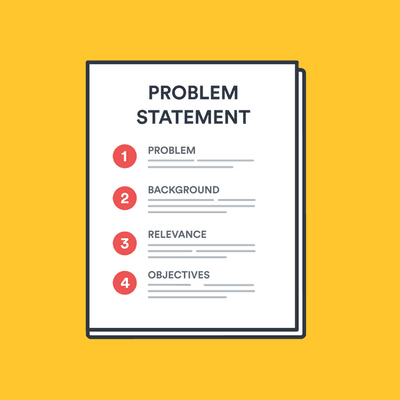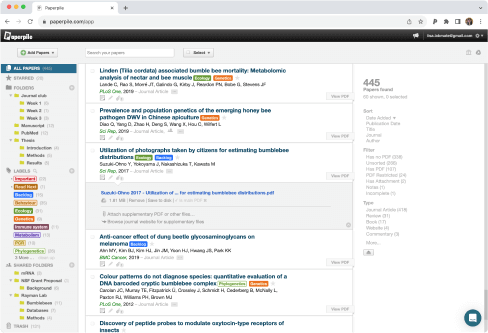How to Write a Problem Statement | Guide & Examples
A problem statement is a concise and concrete summary of the research problem you seek to address. It should:
Essay Due Soon? Let Our Experts Help You Beat the Deadline!
Tell us about your assignment and we will find the best writer for your paper. Our Essay writing service covers over 243 courses and programs, catering to your specific needs.
Write My Essay For Me!- Contextualize the problem. What do we already know?
- Describe the exact issue your research will address. What do we still need to know?
- Show the relevance of the problem. Why do we need to know more about this?
- Set the objectives of the research. What will you do to find out more?
Table of contents
- When should you write a problem statement?
- Step 1: Contextualize the problem
- Step 2: Show why it matters
- Step 3: Set your aims and objectives
- Problem statement example
- Other interesting articles
- Frequently asked questions about problem statements
When should you write a problem statement?
There are various situations in which you might have to write a problem statement.
In the business world, writing a problem statement is often the first step in kicking off an improvement project. In this case, the problem statement is usually a stand-alone document.
In academic research, writing a problem statement can help you contextualize and understand the significance of your research problem. It is often several paragraphs long, and serves as the basis for your research proposal. Alternatively, it can be condensed into just a few sentences in your introduction.
A problem statement looks different depending on whether you’re dealing with a practical, real-world problem or a theoretical issue. Regardless, all problem statements follow a similar process. NoteGenerative AI tools like ChatGPT can be useful at various stages of the writing and research process and can help you to formulate your research problem. However, we strongly advise against trying to pass AI-generated text off as your own work.
AI-generated outputs are not always original and may be detected by your university’s plagiarism checker or AI detector.
Step 1: Contextualize the problem
The problem statement should frame your research problem, giving some background on what is already known.
Practical research problems
For practical research, focus on the concrete details of the situation:
- Where and when does the problem arise?
- Who does the problem affect?
- What attempts have been made to solve the problem?
ExampleVoter turnout in the Southeast has been decreasing steadily over the past ten years, in contrast to other areas of the country. According to surveys conducted by local nonprofits, turnout is lowest among those under 25 years of age. There have been some effective attempts at engaging these groups in other regions, and in the last two elections, major parties increased their campaigning efforts. However, these interventions have yet to have any significant effect on turnout.
Theoretical research problems
For theoretical research, think about the scientific, social, geographical and/or historical background:
- What is already known about the problem?
- Is the problem limited to a certain time period or geographical area?
- How has the problem been defined and debated in the scholarly literature?
ExampleIn the past ten years, the “gig economy” has become an increasingly important segment of the labor market. People under 30 are now more likely to engage in freelance arrangements (rather than full-time jobs) than in the past. Research on the reasons for and consequences of this shift has focused on objective measures of income, working hours, and employment conditions. However, there has been little work exploring young people’s subjective experiences of the gig economy.
Step 2: Show why it matters
The problem statement should also address the relevance of the research. Why is it important that the problem is addressed?
Don’t worry, this doesn’t mean you have to do something groundbreaking or world-changing. It’s more important that the problem is researchable, feasible, and clearly addresses a relevant issue in your field.
Practical research problems
Practical research is directly relevant to a specific problem that affects an organization, institution, social group, or society more broadly. To make it clear why your research problem matters, you can ask yourself:
- What will happen if the problem is not solved?
- Who will feel the consequences?
- Does the problem have wider relevance? Are similar issues found in other contexts?
ExampleLow voter turnout has been shown to have negative associations with overall civic engagement. It is becoming an area of increasing concern in many European democracies. When specific groups of citizens lack political representation, they are likely to become more excluded over time, leading to an erosion of trust in democratic institutions. Addressing this problem will have practical benefits for the Southeastern US as well, and will contribute to understanding of this widespread phenomenon.
Theoretical research problems
Sometimes theoretical issues have clear practical consequences, but sometimes their relevance is less immediately obvious. To identify why the problem matters, ask:
- How will resolving the problem advance understanding of the topic?
- What benefits will it have for future research?
- Does the problem have direct or indirect consequences for society?
ExampleLiterature on the gig economy characterizes these new forms of employment sometimes as a flexible, active choice and sometimes as an exploitative last resort. To gain a fuller understanding of why young people engage in the gig economy, in-depth qualitative research is required. Focusing on workers’ experiences can help develop more robust theories of flexibility in contemporary employment, as well as potentially informing future policy objectives.
Step 3: Set your aims and objectives
Finally, the problem statement should frame how you intend to address the problem. Your goal here should not be to find a conclusive solution, but rather to propose more effective approaches to tackling or understanding it.
The research aim is the overall purpose of your research. It is generally written in the infinitive form:
- The aim of this study is to determine…
- This project aims to explore…
- This research aims to investigate…
The research objectives are the concrete steps you will take to achieve the aim:
- Qualitative methods will be used to identify…
- This work will use surveys to collect…
- Using statistical analysis, the research will measure…
Practical research aims and objectivesThe aim of this research is to investigate effective engagement strategies to increase voter turnout in the Southeast. It will identify the most significant factors in non-voting using surveys and interviews, followed by conducting experiments to measure the effectiveness of different strategies. Theoretical research aims and objectivesThis project aims to better understand young people’s experiences in the gig economy. Qualitative methods will be used to gain in-depth insight into the motivations and perceptions of those under 30 engaged in freelance work across various industries. This data will be contextualized with a review of recent literature on the gig economy and statistical analysis of demographic changes in the workforce.
The aims and objectives should lead directly to your research questions.
Here’s why students love Scribbr’s proofreading services
Problem statement example
You can use these steps to write your own problem statement, like the example below.
Problem statement example
Step 1: Contextualize the problem
A family-owned shoe manufacturer has been in business in New England for several generations, employing thousands of local workers in a variety of roles, from assembly to supply-chain to customer service and retail. Employee tenure in the past always had an upward trend, with the average employee staying at the company for 10+ years. However, in the past decade, the trend has reversed, with some employees lasting only a few months, and others leaving abruptly after many years.
Step 2: Show why it matters
As the perceived loyalty of their employees has long been a source of pride for the company, they employed an outside consultant firm to see why there was so much turnover. The firm focused on the new hires, concluding that a rival shoe company located in the next town offered higher hourly wages and better “perks”, such as pizza parties. They claimed this was what was leading employees to switch. However, to gain a fuller understanding of why the turnover persists even after the consultant study, in-depth qualitative research focused on long-term employees is also needed. Focusing on why established workers leave can help develop a more telling reason why turnover is so high, rather than just due to salaries. It can also potentially identify points of change or conflict in the company’s culture that may cause workers to leave.
Step 3: Set your aims and objectives
This project aims to better understand why established workers choose to leave the company. Qualitative methods such as surveys and interviews will be conducted comparing the views of those who have worked 10+ years at the company and chose to stay, compared with those who chose to leave.
Other interesting articles
If you want to know more about the research process, methodology, research bias, or statistics, make sure to check out some of our other articles with explanations and examples.
How to write a problem statement

What is a problem statement?
Definition
A problem statement is a clear and concise description of the problem or issue a team aims to address in a project.
A problem statement identifies a problem’s current state, desired future state, and the gaps that lie between the two. It doesn’t define the solution to the problem or provide a road map for solving the problem; it only gives an outline of what the problem is.
However, the researcher or team can later use the problem statement to validate that their work delivered an outcome that resulted in the solution.

Why write a problem statement?
A problem statement is a useful communication tool, as it keeps the whole team on track and tells them why the project is important. A problem statement helps someone to define and understand the problem, identify the goals of the project, and outline the scope of work.
A problem statement is especially relevant for projects that aim to improve processes, as it allows for the easier development of solutions. Referencing it helps guide the activities carried out and aids the research team in staying focused. The information in a problem statement also helps a team make important decisions.
When the desired solution is implemented later on, a problem statement can help make sure that steps are put into place to prevent the original problem from recurring in the future.
When are problem statements commonly written?
Problem statements are used in both academic and business contexts. In a business environment, project managers can use them to help execute process improvement projects.
But in an academic setting, they can help researchers to contextualize and understand the significance of the problem in a research project. This guide focuses on academic problem statements.
How do I write a problem statement?
Before planning or writing out your academic problem statement, ask yourself some important questions, and make notes with your answers:
Problem statement key questions
- What is the problem?
- How often does the problem occur?
- Where does the problem occur?
- When does the problem occur?
- Who does the problem impact?
- What causes the problem?
- How would things ideally work if the problem wasn’t present?
- Why is this a problem, and why does it matter?
- What impact does the problem cause?
- Which possible solution/s to the problem are you going to propose?
- What are the predicted benefits or outcomes of your solutions?
The format of a problem statement
When you write your problem statement, split it into four sections:
- Problem: Here, simply define what your problem is, clearly and concisely. Make it no longer than one or two sentences.
- Background: This is the section where you can describe what causes the problem, how often it occurs, where and when it occurs, and who the problem impacts.
- Relevance: You’ll want to show how the problem is relevant, as well as why it matters and requires a solution. This is a great space to specify why it’s a problem and what impacts it causes. If it fits comfortably, you can also articulate how things would ideally work if the problem wasn’t present.
- Objectives: This section doesn’t require great detail or length, as the problem statement isn’t the area of your research project in which to specifically problem-solve. However, you should lay out a brief plan of what you’re going to do to investigate and how that should help you formulate solutions. You can also hypothesize on possible solutions you’re going to propose, and the benefits you predict from these.
The trademarks of a good problem statement
A quality problem statement should be:
- Concise: You should be able to summarize your problem, as well as the different elements of how and why it’s a problem, in succinct sentences. If you can’t, revisit your initial notes and clarify what you want to achieve with your project.
- Specific: Only write about one issue in a problem statement, even if there’s more than one impact of that issue. Your research and actions then only have to focus on solving the one problem, and there’s no confusion.
- Measurable: Be clear about how you’re able to measure and convey both the problem and your proposed objectives. This is usually by communicating the problem in terms of degree and frequency.

An example of a problem statement
Below is an academic problem statement example. You don’t need to include any headers in your real problem statement, but we’ll do so here to show you how the sections of the document function in practice.
Problem
Problem example
There is worryingly low uptake of free cervical cancer screening in the UK amongst women aged 25 to 35.
Background
According to an assessment conducted by X Health Trust, only 60% of 25- to 35-year-old female patients attended cervical cancer screening appointments within the last two years.
This could be due to several contributing factors:
- Female patients in this age group may be more likely to believe they are not susceptible to cervical cancer due to their younger age.
- There has been an absence of regular and informative public health announcements on this subject within the last seven years.
- Cervical cancer screening has a reputation for being an unpleasant experience, which could be off-putting for patients due to attend one.
Relevance
Cervical cancer is the 14th most common cancer in females in the UK, representing a notable health risk. As of 2017, there were around 3,200 new cervical cancer cases, with 850 consequent deaths, in the UK every year.
Although mortality rates in the UK for cervical cancer are highest in females aged 85 to 89, incidence rates for the disease are still highest in females aged 30 to 34.
When cervical cancer is diagnosed at its earliest stage, 96% of people diagnosed will survive their disease for one year or more. This is compared with only 50% of people when the disease is diagnosed at the latest stage.
Screening is a vital health service as many cervical cancer patients will be symptomless until they are in a later stage of the disease.
Objectives
We are going to conduct a survey of 10,000 females in the UK between the ages of 25 and 35. We will first ask them the question of whether they have attended a cervical screening appointment in the last five years. For those who answer “no,” we will then present them with multiple-choice options that answer the question, “why not?”
From the results we gather, we should be able to accurately assess the most common reasons why there is a low uptake in cervical cancer screening in this age group. We will then propose interventions to the medical community based on our findings.
Our ultimate goal is to increase the uptake of cervical cancer screening by females between 25 and 35 in the UK over the next five years.
Problem statement checklist
🔲 Problem
🔲 Background
🔲 Relevance
🔲 Objectives
Can You Do My Homework for Me?
YES, ⚡ Experience the brilliance of our essay writers from the US, UK, Canada, or Australia by entrusting us with your next essay.
NursingEssayHub.com is a distinguished ONLINE ESSAY WRITING AGENCY that specializes in offering expert writing help and assistance to students across all academic levels. With a team of highly skilled writers and editors boasting years of academic writing experience, we are fully equipped to guide you throughout the entire process, from selecting the perfect topic for your paper to completing a thorough literature review and delivering a well-formatted final draft.

ORDER A SIMILAR ESSAY WRITTEN FROM SCRATCH at : https://nursingessayhub.com/




